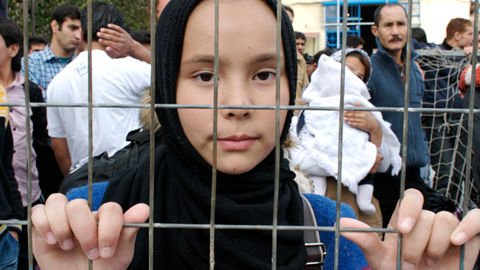Jamila* is a five-year-old girl born to Afghan parents in Turkey. Along with her younger brother, she has lived all of her young life without a country, waiting for her parents’ refugee claim to be processed. She and other refugees her age will likely not be able to read and write in their native language because of a lack of schooling.
Jamila’s story is now coming to the fore as an organization, known as the Coordination Group of Afghan Refugees in Turkey, is beginning to campaign for better, speedier processing of their cases by UNHCR in Turkey.
Turkey is the only signatory of the UN Refugee Convention that has a de facto policy of not recognizing people outside the Council of Europe as refugees, according to Amnesty International. As a result, UNHCR in Turkey has to process the claims of the several thousand refugees from Afghanistan, Iraq, Iran and, most recently, Syria.
Yet, the demands of the Afghan refugees, outlined in an open letter to UNHCR on the occasion of World Refugee Day, are simple:
> Translators must be proficient in Dari and must understand Afghan culture to ensure that refugees’ accounts are recorded correctly and in full.
> Interviews must be made comfortable; asylum-seekers should not feel criminalized by interviewers.
> Full and clear reasons for rejection must be disclosed in a detailed format, directly to the refugee, immediately after a decision has been made.
Afghan refugees in Turkey constitute a small part of an unnoticed deluge of Afghans who have been leaving the country in the last few years.
Ten years after the fall of the Taliban, the dire humanitarian situation in Afghanistan continues to be the source of the largest refugee and the second-largest asylum seeking population in the world. Despite pushback from several destination countries, real concerns about personal safety, persecution and economic deprivation drive Afghans in large numbers to outside countries, where they often live in deplorable conditions.
UNHCR statistics show that in 2010, three million refugees out of the 15.6 million worldwide – nearly one in every five – were Afghans. Of the nearly 700,000 asylum applications lodged in 2009 and 2010 in 44 industrialized nations of the world, nearly 52,000 – one in every 13 – were from Afghans. Along with Somalia, Afghanistan is the largest source of unaccompanied minors seeking asylum. Yet, Afghanistan constitutes only about 0.005% of world population.
Many Afghans, illiterate and uneducated, do not understand UNHCR’s claim procedures and regard them as inefficient and time-consuming, choosing not to register with the agency and to pursue claims independently. As a result, the number of actual Afghan refugees and asylum seekers may be significantly higher than what UN records show.
Most Afghan refugees settle in the neighboring countries of Pakistan and Iran, yet a growing number of them undertake perilous journeys across the world for asylum.
Thousands of young Afghan men, some of them underage, smuggle themselves into Iran to get to Turkey, their gateway into Europe. The most common path from Turkey onwards is like this: Crossing the Aegean Sea to get to Greece, the asylum seekers make their way to Italy and then to France, Germany, the United Kingdom, Norway and Sweden – countries that are the largest recipients of asylum claims from Afghans.
By the time they make it to France, asylum seekers will have gone through a number of difficult situations – from mistreatment in the hands of authorities in Iran and Turkey, to leaky, overloaded boats in the Aegean Sea, to xenophobic vigilante groups targeting refugees in Greece, to dark, cramped and congested cargo trucks they use to smuggle themselves from Italy into France. For some, it takes years to get to a destination country. Some work – legally or illegally – at each destination point to earn enough money for the next leg of the journey.
Many attempt the journey multiple times, others are captured and deported, some die trying.
But even for the lucky ones who make it to a destination country, asylum is not guaranteed – not even for unaccompanied minors – because of a Europe-wide shift in attitudes toward Afghan asylum seekers in recent years. The UK, for example, set up a “reintegration center” in Kabul in 2010 to deport unaccompanied minors applying for asylum. Norway, Denmark, Sweden and the Netherlands have either announced plans to build similar reintegration centers in Afghanistan for unaccompanied minors, or are preparing to simply deport them.
Australia, another major recipient of asylum applications from Afghans, recently tightened its asylum policy, a move that has provoked universal condemnation from the UN, human rights organizations, and even the Australian parliament.
Afghanistan continues to suffer from 40% poverty rate, a rapidly degenerating security situation and a human rights condition that even the US State Department paints as bleak.
On top of that, smaller-scale emergencies and crises (by Afghanistan standards) continue to generate internally displaced people, currently totaling more than 350,000 by UNHCR’s count. Displacement from conflict – such as the military operations in Helmand, the Kuchi-Hazara conflict in Ghazni and Maidan-Wardak – and natural disasters such as floods and droughts push thousands of families to seek safety or opportunities elsewhere within a country that is scarcely able to provide either.
Ten years of lackluster development compounded by the worsening insurgency is helping brew a humanitarian crisis that is pushing more people to become refugees or seek asylum abroad. The expected deterioration in the security situation from the withdrawal of international forces is only going to drive more desperate young men to consider asylum abroad as their only ticket to a better life.
*Actual name withheld.
Feature image credit: Noborder Lesvos/Independent World Report.
